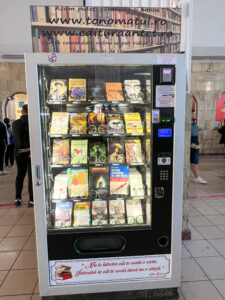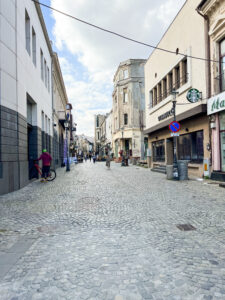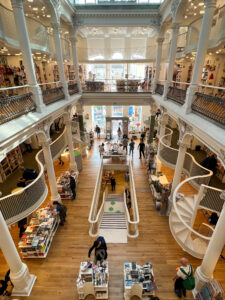
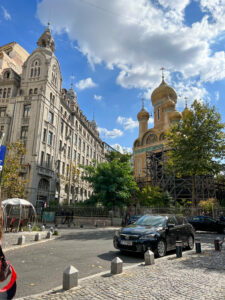
After all my uncertainty about visiting Romania amid the nuclear tension in Ukraine and then the logistical fiasco of getting there, I felt a bit shell-shocked once I finally arrived. I wasn’t prepared for the size of Bucharest. I’d read that Bucharest is the 6th largest city in the European Union (depending on which publication you read), but it was hard to visualize what that meant before seeing it. What it meant was navigating a 30-minute metro ride and then a half-mile walk through town to get to my hostel from the Central train station. I hurried to try to get there before dark so I wouldn’t have to walk at night alone.
I didn’t know a lot about Bucharest before I visited. Though I’ve been enthralled by Romania for a long time, it was mostly Transylvania that I imagined when I dreamed of visiting. Bucharest felt like a necessary stop-over to get to the good part. The majority of what I’d read about Bucharest was either outdated or negative. I read that during the early 1900s, Bucharest was known as the Paris of the East, but current travel bloggers found the city boring, dirty, and ugly. I read that in recent years, stray dogs had overwhelmed the city and had killed people in the streets. (For the record, though I saw hundreds of stray dogs in Eastern Europe, I don’t think I saw even one in Bucharest.) I had read about communism in Romania and Nicolae Ceausescu’s regime, and I’d read that even three decades later, the shadow of oppression and misery still lingers. “Skip the city—the splendor that used to be here is gone, and it’s not worth a visit now,” many of the online guides suggested. It left me with images of crumbling structures, empty storefronts, and sprawling concrete. I’d learned already not to form negative opinions based on stereotypes and other people’s bad experiences, but my expectations weren’t high.
In fact, Bucharest really does have a lot of sprawling concrete and ugly buildings. But that makes the things hidden behind the façade all the more interesting. Back in 1971, dictator Ceaucescu visited North Korea and was treated like royalty. He was so impressed with their communist system that he returned home to Bucharest determined to replicate what he found there. He destroyed (or hid) much of what was unique and beautiful about the city to create giant boulevards and socialist structures that make the city less visually appealing than it was before. Once you learn how the beauty here was deliberately hidden during communism, it changes how you view it. There’s so much beauty if someone shows you where to look.

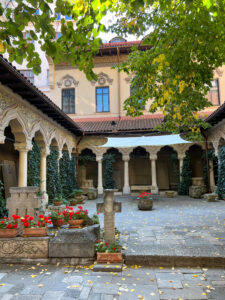

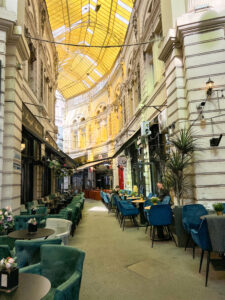
In my mind, the communist revolution felt like distant history. Part of what felt so striking when I was visiting Bosnia and learning about the Yugoslav Wars was how recent those horrors were. It felt inconceivable that such horrors happened in my lifetime, that if I had lived there, I would remember it. But Romania’s dark past was outside the scope of my memories, history that my parents could remember but that felt further removed from me. It’s a trick of time, though. It wasn’t until I was in Romania that I fully grasped the fact that I was alive when the communist revolution happened. I was two months old when Ceausescu and his wife were executed, ending almost half a century of communism. Each of us only has our own memory as a guide to conceptualize time, and as a result, I think the past is never as distant as we imagine it to be. As I wandered the city, it occurred to me that most adults I saw had memories more terrible than I could imagine. Just as I felt in Krakow, in Sarajevo, in Tirana (and how I’d end up feeling later in Mostar), it is astonishing how resilient people are.
Reading about Romania’s recent history couldn’t compare to hearing a local guide teach us about the history while standing where it took place. It took effort not to cry when our tour guide told us about the revolution and how 16-year-old boys stood in front of the tanks in the university square because they believed that a human shield could stop them. It didn’t. The tanks just ran over them, and then even more people joined in the rebellion because they knew they couldn’t live that way any longer. It’s hard for me to imagine anything where I come from requiring that level of courage.
The Old Town in Bucharest was not destroyed by Ceausescu, and it’s the most beautiful part of the city today. It’s a touristy area, but not so touristy that it felt tacky or off-putting. There were street musicians playing violins and beautiful churches and tons of restaurants. In the Old Town, I visited the famous bookstore Cărturești Carusel, which is one of the things I was most looking forward to in all of Romania. Along with Livraria Lello in Porto, it’s one of the most beautiful bookstores I’ve ever seen in the world. I bought a leather journal there that was crafted by local Roma people with proceeds going to them. I’m on a never-ending quest to find the most perfect journals, and trust me when I tell you that there are few journals more perfect than this one. I could have spent a week in the store without leaving.


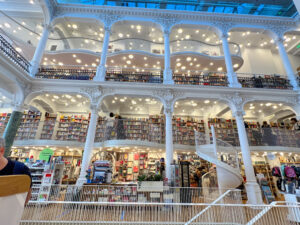
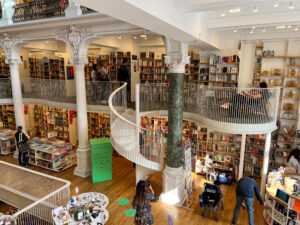
I stayed in a shared room in T5 Social Hostel for my two nights in Bucharest—the first time I’d shared a room with strangers since Michael joined me in Budapest 7 weeks prior. I was feeling apprehensive and not very social, but on my first night, everyone in the hostel gathered around a campfire outside for an Open Mic Night. People sang self-written songs, performed dramatic readings of Britney Spears, and sang along with Gangster Paradise at the top of their lungs. Everyone clapped and praised each performance as if it were a masterpiece. Inside, stunning drawings and paintings hung on all the walls, all created by guests during art nights. There were guitars and a piano and a full bookshelf curated by color. It felt like a cozy collective for artists and intellectuals.
It was different than any hostel I’d been in before in the way that it felt like a community space instead of a place exclusive to backpackers who were passing through. Events each night seemed to be open to young people in the community, and I met locals around my age who came to events each week to meet new people. On my first night when I was aggressively perusing the books in the library area, I met a guy who was visiting his family in Bucharest (where he’s from) while pursuing his PhD at Cambridge. “What are you studying?” I asked him, and he said to me with a small smile, “I’m studying the end of the world.” Please do not forget, dear reader, that I almost didn’t visit Romania so intense was my paranoia that Putin was about to start dropping nukes at any moment just a day’s drive away. I wanted to cover my ears and run. But I felt this really necessitated follow-up. And also I was curious.
“What does such study… entail?” I asked him.
He told me that he specifically studies how societies collapse.
“Well?” I asked him. “Have you decided what the verdict is for us?”
“I feel hopeful,” he told me. “Studying this makes me know what steps we can take to make positive changes, and I feel hopeful about it.”
We sat on cushions on the floor and petted the hostel cat, and he wasn’t worried about nuclear war, so I wasn’t either.

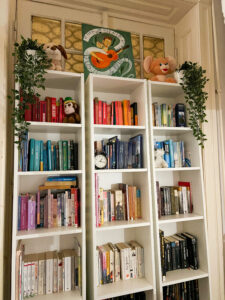

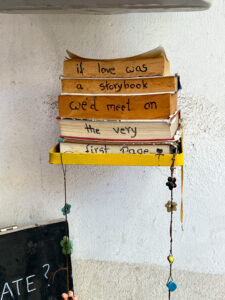
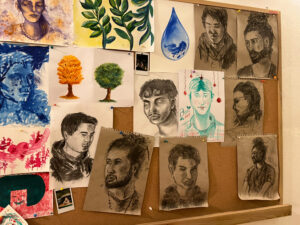

My second night there was a Friday night. This is typically the night that the more social hostels have their loudest and largest events—the pub crawls or karaoke or some sort of raucous thing that makes me feel 20 years older than I am to even consider. At T5 Social, Friday night means Trivia Night. People were THRILLED about Trivia Night. There were far more participants there for trivia than there were actually staying in the hostel. When Trivia is the highlight of the week’s events for the whole community, that’s how I know I’ve landed in the right place. I’d barely started trying to remember how to be social after two years of intense isolation when Michael joined me, and then I had him to lean on as a social bridge for nearly two months. Trivia felt like a good activity for trying to remember how to talk to strangers on my own again. I ended up on a team with two other solo travelers. Igor was visiting family in neighboring Serbia and hopped over to Romania for a few days because he’d never been. Carmen was visiting from the coast of Romania and seemed like the kind of bubbly and personable soul who’s never met a stranger. She told us about her favorite places in the country and what we shouldn’t miss. After an intense trivia battle that lasted hours, we came in 2nd place, and I remain proud of this near-victory.
Igor had one full day left in the country before heading back to his home in Canada, and he was looking to do a day trip. I was planning to take the train to my next Romanian destination, Brasov, so we decided to go there together. Igor seems like the kind of calm and collected person who’s up for anything and has perhaps never raised his voice in his life. He is who you want on your trivia team and also who you want with you when you find yourself navigating impossible travel obstacles. We woke up early and made the trek to the metro and then across the city to the train station as he told me about Toronto and I told him about New Orleans. We finally made it to the train station only to discover that the train we needed was sold out. We took turns trying to understand at the ticket window. Can we get a ticket for the next train? How about the next one? Could they tell us when there was a train with open seats? The answer seemed to be, “There are no seats today, and you’re out of luck.”
We got a snack and googled and deliberated. I looked at bus options. All sold out for the day. We tried to buy tickets online for any morning train. Nope. We tried to buy tickets at the self-service ticket machine. Nope. Finally we found a person at the info desk who explained that we could buy a ticket on the train itself and that we didn’t have to have a ticket to board. You may just have to stand, they explained. It was a nearly-3-hour ride to Brasov. I pictured us sitting on the floor in a corner of the train car, chatting while we watched the mountains get larger outside. It seemed like a fine plan to both of us.
Unfortunately, this was everyone else’s plan, too. We got on the train and the passengers kept coming and coming until we were packed as tightly as the New York City subway at rush hour. For a tall person (Igor), I imagine this was a miserable thing to endure for close to 3 hours. For a 5-foot-tall claustrophobic person (me), this would have felt like being trapped in an MRI machine while suffocating. I gave in to defeat and told Igor he had to go without me. He had no choice but to stay on the train since he needed to get back to Bucharest early enough to pack and be ready for his early flight. He helped me squeeze my bag off the train, and I waved to him from the platform feeling relieved that I wasn’t stuck amidst the sea of elbows. (Don’t worry, Igor, survived the nearly 3-hour trip seemingly without panicking or suffocating. I knew he was a sturdy soul.)
I sat down on the platform and searched each different train company’s website until I found a ticket I could purchase for an early afternoon train. I had 3 hours to wait, which wasn’t quite enough time to go all the way back downtown but was far too long to sit in a tired stupor at the train station. What is there for a person to do near Bucharest’s central station? The answer is not much, but while I scoured Google Maps, I did see that the Natural History Museum was just a 15-minute walk away. I figured out how to put my luggage in a storage locker and went in search of it. The Natural History Museum in Bucharest is really not a tourist attraction. Trust me when I tell you that this is not a thing you need to seek out on your trip there. The only other people there when I arrived were kids on school trips. But I was in luck—there was a special snake and frog exhibit I could pay a couple extra dollars to see. I wandered around the mostly-empty museum and looked at creepy dead animals and then to the snake and frog exhibit to hang out with the (live) reptiles and amphibians. It felt like a fitting way to end my visit to this odd and special city. Back at the train station, I caught my train where I had my very own seat and no crowds touching me. I’d arrived in Bucharest feeling apprehensive, but I left it feeling tired, content, and excited for what would come next.


